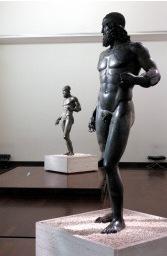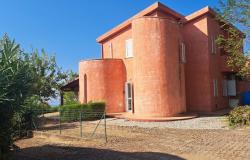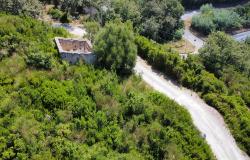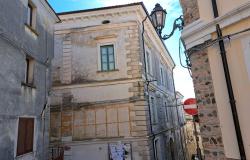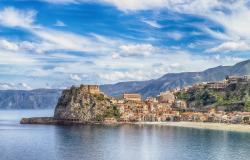Thirty-five years after the famed Riace bronzes emerged from the sea, a probe into a third ancient statue thought to have gone missing at the time is gathering pace.
Prosecutors, investigating the claims of local art sleuth Giuseppe Bragho', say there is growing evidence that a third work of art was smuggled from the scene during the discovery.
Bragho', an expert on his local Calabria region where the sensational bronzes appeared in 1972, says he has "tracked down and photographed a series of documents that indicate an alarming scenario".
He says a third statue - "completely different from the other two" - as well as two shields and a lance, were seen lying on the seabed by the finder, scuba diver Stefano Mariottini.
Bragho' points to a statement made by Mariottini the day after he discovered the statues on 16 August 1972.
In the statement, he refers to "a group of statues".
He also says the "two protruding statues [...] were free of any clear incrustations".
Yet Bragho' has found a previously unpublished photograph of the statues apparently showing one of the figures entirely covered in incrustations, its features indistinguishable.
Bragho' also highlights another section of Mariottini's statement in which he reportedly said he saw "three statues, probably made of bronze...one of them lying on its side with a shield on its left arm".
In addition, the expert has provided prosecutors with the name of a man who allegedly helped smuggle a shield and lance away from the scene of the discovery.
As further evidence of his theory, Bragho' has produced a series of recordings of a male voice, who claims he acted as a mediator for representatives of the John Paul Getty Museum in Los Angeles.
Bragho' believes that the alleged weapons and possible third bronze ended up in the museum's collection.
However, the institute has vigorously denied the claims, categorically stating: "the spear, shields and helmet purportedly found with the bronzes have never been part of our collection.
"This information is wrong and must be corrected," the museum said.
ONE OF ITALY'S MOST IMPORTANT FINDS OF THE LAST 100 YEARS.
The bronzes were discovered by Mariottini, an amateur scuba diver from Rome, during a holiday on the Calabrian coast.
They turned out to be one of Italy's most important archaeological finds of the last 100 years.
The statues are of two virile men, presumably warriors or gods, who possibly held lances and shields at one time. At around two metres, they are larger than life.
The 'older' man, known as Riace B, wears a helmet, while the 'younger' Riace A has nothing covering his rippling hair. Both are naked.
Although the statues are cast in bronze, they feature silver lashes and teeth, copper red lips and nipples, and eyes made of ivory, limestone and a glass and amber paste.
Italy is renowned for its archaeological treasures but the Riace bronzes have attracted particular attention.
This is partly because of their exceptionally realistic rendering and partly owing to the rarity of ancient bronze statues, which tended to be melted down and the metal reused.
Mariottini, who spotted the statues 300 metres off the coast and eight metres underwater, said the bronze was so realistic he initially thought he'd found the remains of a corpse.
When they first went on display in 1981, a million people came to see them and the pair were even featured on a commemorative postage stamp.
Today the statues pull some 130,000 visitors each year to the Reggio Calabria museum housing them.
How or when the statues sank to their watery resting place also remains a mystery, as divers uncovered no wreckage in the vicinity.
While remains could have drifted to the seabed some distance away it is more probable that the statues were tossed overboard, either to lighten the ship's load in a storm or to prevent them falling into the hands of pirates.
Culture Minister Francesco Rutelli recently greenlighted a fresh scientific mission to the area, after a US ship reported detecting traces of underwater metal near the spot the statues were discovered.
